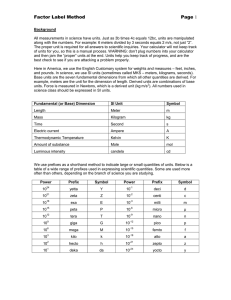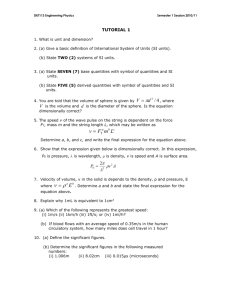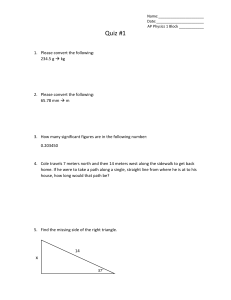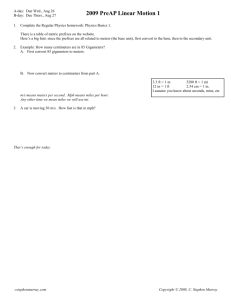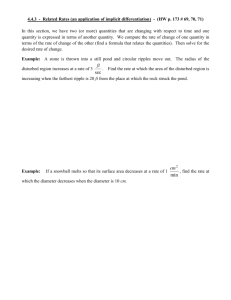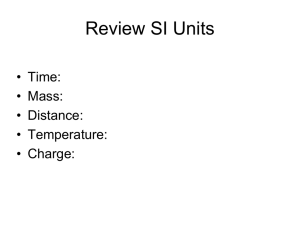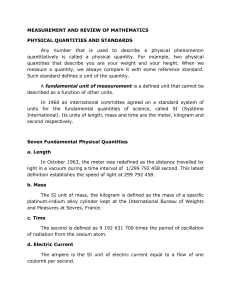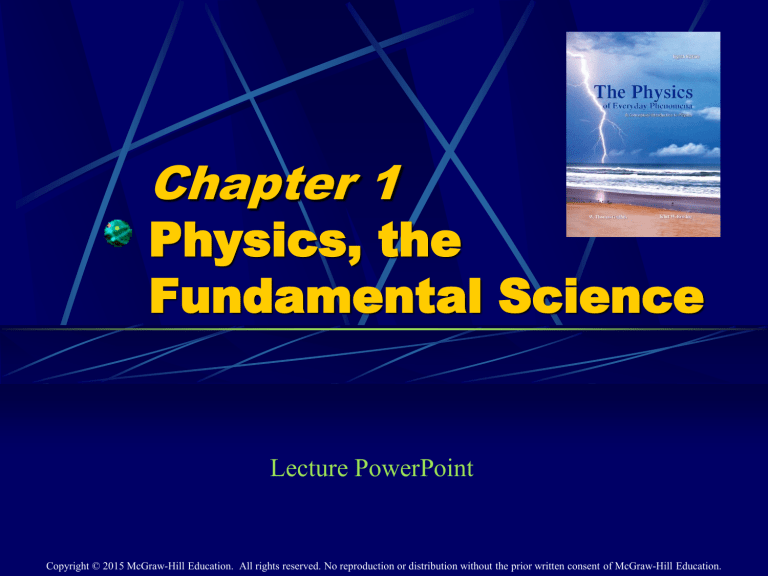
Chapter 1 Physics, the Fundamental Science Lecture PowerPoint Copyright © 2015 McGraw-Hill Education. All rights reserved. No reproduction or distribution without the prior written consent of McGraw-Hill Education. Objectives of Physics To find the limited number of fundamental laws that govern natural phenomena To use these laws to develop theories that can predict the results of future experiments Express the laws in the language of mathematics Mathematics provides a bridge between theory and experiment Physics predicts how nature will behave in one situation based on the results of experimental data obtained in another situation. Physics experiments involve the measurement of a variety of quantities. These measurements should be accurate and reproducible. Physics is exact science The first step in ensuring accuracy and reproducibility is defining the units in which the measurements are made. Subfields of Physics Classical Physics Mechanics - forces and motion Thermodynamics - temperature, heat, energy Electricity and Magnetism Optics - light Modern Physics Atomic physics - atoms Nuclear physics - nucleus of the atom Particle physics - subatomic particles: quarks, etc Condensed matter physics - solids and liquids Units To communicate the result of a measurement for a quantity, a unit must be defined Defining units allows everyone to relate to the same fundamental amount System of Measurement Standardized systems agreed upon by some authority, usually a governmental body SI -- Systéme International agreed to in 1960 by an international committee main system used in this text also called mks for the first letters in the units of the fundamental quantities Length Units: SI – meter, m Mass Units: SI – kilogram, kg Time Units: SI – seconds, s Electric Current Units: SI – Ampere, A There are three base units more, but we are not going to use them (mole, kelvin and candela) Fundamental Quantities and Their Units Quantity SI Unit/abbreviation Length Meter (m) Mass Kilogram (kg) Time Second (s) Electric Current Ampere (A) Absolute Temperature Kelvin (K) Luminous Intensity Candela (Ca) Amount of Substance Mole (M) Prefixes Prefixes correspond to powers of 10 Each prefix has a specific name Each prefix has a specific abbreviation The General Conference on Weights and Measurements recommended the prefixes shown Examples: Write the following lengths in meters : a) b) c) d) e) 62.8 km = 62.8*103 In Scientific Notations 6.28*104 33.3 nm = 33.3*10-9 m;In Scientific Notations 3.33*10-8 13.6mm =13.6*10-6 m In Scientific Notations 1.36*10-5 2.5 mm = 2.5*10-3 m 3.1 *103 cm = 3.1*103*10-2 = 31 m Write each of the following numbers using the appropriate prefix: a) 1.2*106 Hz = 1.2MHz b) 3.2 *10-9 s = 3.2 ns c) 4.5 *103 m = 4.5 km d) 6.8 *10-3 m = 6.8 mm Dimensional Analysis Technique to check the correctness of an equation dimensionally Cannot give numerical factors: this is its limitation Dimensions (length, mass, time, combinations) can be treated as algebraic quantities add, subtract, multiply, divide Both sides of equation must have the same dimensions Example x= vt2 x is the distance in meters, v is the speed in m/s and is the time in seconds. Is this equation correct dimensionally? Distance is in meters thus the right hand side of the equation MUST be in meters. x= vt2 m m/s*s2= m/s ; the left hand side is in meters the right hand side is m/s thus this equation is NOT correct. Example: x= 1/2at2 Is this equation correct dimensionally? m =m/s2*s2 =m thus this equation is correct a= acceleration iti sin m/s2 Conversions When units are not consistent, you may need to convert to appropriate ones Units can be treated like algebraic quantities that can “cancel” each other See the inside of the front cover for an extensive list of conversion factors Example: A car travels through a school zone at a speed of 25mil/h. What is this speed in km /h, and in m/s? Conversion factors: 1 mil=1.6 km, 1km=1000m 25mil*1.6km/mil.h = 40 km/h 40km/h *1000m/km *1/(60*60)s/h=11.11 m/s Pythagorean Theorem The sides of a right angle triangle are related according to Pythagorean Theorem as follows; r2 = x 2 + y 2 r y x Problem Solving Strategy Rules for rounding off numbers Consider the first number to the right of the required number if This number is less than 5, then the preceding digit remains the same Example: 2.674998765 2.67 If this number equal to or greater than 5 then add one to the preceding digit. 2.350012.4
